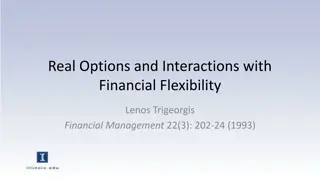Rural Hospital Flexibility Program in Montana: Enhancing Quality Care
The Rural Hospital Flexibility Program in Montana, managed by the Montana Health Research and Education Foundation, focuses on developing quality care initiatives for small rural hospitals. With a mission to improve healthcare performance and customer satisfaction, the program includes various quali
1 views • 35 slides
Equitable Services for Private School Children and Teachers
The Elementary and Secondary Education Act of 1965, specifically Title VIII, Part F, outlines the provision of equitable services for eligible private school children, teachers, and other educational personnel. This non-regulatory guidance emphasizes the importance of ensuring fairness and support f
4 views • 32 slides
Organizational Flexibility in ICS
Explore the concept of organizational flexibility within the standard ICS structure, learning how the modular organization can expand and contract based on incident complexity and size. Delve into the guiding principles of NIMS, the importance of standardization alongside flexibility, and key consid
1 views • 33 slides
New Jersey Department of Education ESEA Consultation Requirements
The New Jersey Department of Education outlines the roles and responsibilities for providing equitable services to nonpublic schools under ESEA guidelines. This includes the responsibilities of the State Education Agency, Local Districts, and Nonpublic Schools in ensuring fair access to educational
0 views • 34 slides
Grant Management Flexibility under Horizon 2020 During COVID-19
Grant management under Horizon 2020 during COVID-19 requires maximum flexibility with eligibility of costs incurred, force majeure clause usage, and flexibility in actual personnel costs. Teleworking costs are eligible, and personnel costs can be adjusted for exceptional circumstances. Travel costs
2 views • 12 slides
Flexibility: Types, Methods, and Benefits
Flexibility is the ability of joints to move within their maximum range, crucial for overall health and sports performance. It can be passive or active, and there are various methods to enhance it such as ballistic, static stretching, dynamic stretching, and proprioceptive neuromuscular facilitation
0 views • 8 slides
Enhancing Student Achievement through Title I Programs
Title I, Part A programs at Donna ISD focus on improving basic education programs and increasing parent engagement. Schools receiving funding under ESEA work on extensive planning, ensuring highly qualified staff, providing information to parents, and involving parents in campus decision-making to e
0 views • 10 slides
Centrica's Flexibility Market Vision for Future Markets: Policy and Industry Developments
Centrica's Regulatory Affairs team shared insights at the Cornwall LEM sign-off event regarding the importance of independent flexibility market platforms to deliver transparency, neutrality, and coordination between DSOs and ESOs. They emphasized the need for updated network security standards, add
0 views • 6 slides
Zebra ZT400 Series: Rugged Durability & Application Flexibility
The Zebra ZT400 Series offers rugged durability for demanding applications, loaded with features for flexibility, easy integration, operation, and management. Ideal for industries like manufacturing, transportation, logistics, retail, and healthcare, this series builds on the legacy of the ZM models
0 views • 13 slides
Importance of Flexibility and Stretching for Better Health and Injury Prevention
Flexibility and stretching play a crucial role in preventing injuries, promoting better health, and preparing the body for physical activities. Adequate muscular flexibility allows joints to move efficiently, reducing the risk of compressing tissues or nerves. By incorporating proper stretching tech
0 views • 17 slides
Nebraska Education Standards Implementation Timeline
The timeline outlines the process of aligning the Common Core State Standards with Nebraska's language arts and mathematics standards, involving studies, reviews, revisions, and approvals by the State Board of Education. Implementation is expected to be completed by spring 2014, with school district
0 views • 18 slides
Effective Monitoring Practices for Federal Programs in Education
Effective monitoring practices for federal education programs, such as ESEA Title I-A, II-A, IV-A, V-B, McKinney-Vento, Foster Care, and Equitable Services to Private Schools by the Oregon Department of Education. The monitoring process involves desk monitoring and on-site visits to ensure education
0 views • 23 slides
Alaska ESEA Flexibility Waiver Renewal Overview
Alaska Department of Education & Early Development is proposing a renewal for the ESEA Flexibility Waiver, focusing on key principles such as college and career-ready expectations for all students, state-developed differentiated accountability, and support for effective instruction and leadership. T
0 views • 19 slides
Flexibility and Stretching Techniques
Flexibility is crucial for optimal physical performance and injury prevention. It refers to the ability to move joints through a full range of motion without restrictions. Factors limiting flexibility include tissue elasticity, bony structure, and muscle/tendon extensibility. Understanding active an
0 views • 28 slides
Flexibility and Joint Health
Flexibility is essential for optimal joint health, allowing for smooth movement and reducing the risk of injuries. Joints, ligaments, muscles, and tendons play crucial roles in supporting flexibility and mobility. Maintaining flexibility through activities like static stretching can promote overall
0 views • 43 slides
Equitable Services Requirements and Guidelines under ESSA
Equitable Services Requirements and guidelines under ESSA outline the responsibilities of education officials, ombudsman, and private school administrators to ensure fair distribution of federal funds. The ESEA Team in Maine works to uphold Title I, Part A, Migrant Education, Teacher Quality, Englis
1 views • 56 slides
Education Act of 1965 and Equitable Services for Private School Students
The Elementary and Secondary Education Act (ESEA) of 1965, as amended by the Every Student Succeeds Act in 2015, ensures equitable participation of private school students and teachers in federal education programs. The Office of Non-Public Education (ONPE) oversees this initiative, providing resour
0 views • 30 slides
Budget Narrative for Title III Grants in Oregon Education 2023-24
This budget narrative outlines the goals of Title III grants for the Oregon Department of Education, focusing on aiding English learners in attaining language proficiency and academic achievement. It emphasizes the importance of Supplement not Supplant regulations to ensure proper fund allocation an
0 views • 38 slides
Maine Department of Education ESEA & Assessment Teams Information Session
Maine Department of Education is hosting an informational session introducing the ESEA & Assessment Teams. The session covers topics like assessment goals, performance reports, and growth goals for math and reading. It also provides insights on the Maine Through Year Assessment and the use of MAP Gr
0 views • 20 slides
Oregon Department of Education Update on Educator Effectiveness - 2015 Conference Highlights
Explore key topics from the 2015 COSA Law Conference, including educator effectiveness updates, student growth percentiles, norms for collaboration, learning objectives, ESEA waiver insights, and more.
0 views • 37 slides
Indiana's ESEA Flexibility Waiver
Indiana's ESEA Flexibility Waiver, part of cohort 1, provided flexibility in utilizing the state's own accountability system, allocating Title I funds, and improving academic performance at state and local levels. The waiver aimed to enhance educational outcomes, address achievement gaps, promote eq
0 views • 122 slides
Examining Socioeconomic Status of Childcare Workers in Illinois
Childcare workers in Illinois earn a median hourly wage of $10.5, ranking 35th in hourly wages among 730 occupations. The study aims to understand the flexibility and demographics of childcare workers compared to other occupations with similar wages. Assumptions suggest childcare work is predominant
0 views • 11 slides
Guide for Reporting Recent Arrivers in ESEA Title III 2023-24
Comprehensive information on reporting recent arrivers in education under ESEA Title III 2023-24, including definitions, eligibility criteria, required data, and guidelines. Learn who qualifies, what data to collect, and the importance of reporting foreign exchange students meeting the criteria.
0 views • 38 slides
Enhancing Cognitive Flexibility for Employability
Cognitive flexibility is a crucial skill for adapting to new situations and problem-solving in today's competitive job market. This module focuses on identifying, assessing, and enhancing cognitive flexibility to nurture competitiveness and employability. Learn how to recognize the importance of cog
1 views • 24 slides
2022-2023 Consolidated District Performance Report (CDPR) Overview
Gain insights into the 2022-2023 Consolidated District Performance Report (CDPR) for ESEA CDPR Title I-A regarding students and programs. Discover important data collection details, resource materials, validations, and FAQs provided by the Oregon Department of Education. Utilize the CDPR Title I-A V
0 views • 38 slides
Comprehensive Physical Fitness and Training Guide by Eoin Bradley
Explore the realm of physical fitness through Aerobic Endurance, Skills, Strength, Speed, Power, Flexibility, Mobility, and Agility. Unveil the importance of Mobility, Flexibility, Strength, Aerobic Endurance, and more. Delve into specific training requirements for GAA Football and seasonal training
0 views • 23 slides
The Relationship Between Cognitive Flexibility and Psychological Flexibility After Acquired Brain Injury
This study explores how cognitive flexibility and psychological flexibility interact after an acquired brain injury. It examines whether individuals who exhibit cognitive inflexibility can achieve psychological flexibility, considering the impact of cognitive impairments post-injury. Cognitive flexi
0 views • 21 slides
Enhancing Educational Stability for Children in Foster Care
This detailed walkthrough of federal non-regulatory guidance focuses on ensuring stability for children in foster care, with a particular emphasis on educational stability under ESEA and ESSA provisions. It covers key aspects such as the school of origin, collaboration between SEAs, LEAs, and child
0 views • 26 slides
Psychological Flexibility and Relationship Quality Study
This study explores the relationship between psychological flexibility, individual wellbeing, and relationship quality. It reveals correlations between psychological flexibility, positive affect, negative affect, satisfaction with life, psychological wellbeing, and relationship quality in romantic r
0 views • 18 slides
Overview of Flexibility Study Using EPRI's InFLEXion Tool
The flexibility study aims to assess system flexibility using EPRI's InFLEXion tool for high net load ramp months in 2027. It involves analyzing wind, solar, and load profiles to evaluate flexibility metrics and identify periods of flexibility deficit. The process includes data analysis, production
0 views • 9 slides
Psychological Flexibility through Embodied Knowledge
Psychological flexibility plays a crucial role in mental well-being and behavior. This study explores whether untrained individuals can grasp psychological flexibility concepts based on body language and how people physically express flexibility or inflexibility in response to challenging situations
0 views • 18 slides
Real Options and Financial Flexibility in Financial Management
Understanding real options and their interactions with financial flexibility is crucial in financial management. This study by Lenos Trigeorgis explores the concept in detail, highlighting the importance of incorporating real options analysis in decision-making processes. The research provides valua
0 views • 11 slides
Renewable Energy Strategies for Transmission and Market Flexibility
Explore the strategies and challenges related to renewable energy transmission capacity, market flexibility, and cross-border intraday trading in the European Union. Topics include capacity forecasts, flexibility requirements, balancing control areas, and incentivizing flexible generation. The integ
0 views • 5 slides
Indiana ESEA Flexibility Waiver Update Summary
Indiana ESEA Flexibility Waiver update for June 4, 2014, highlights areas not meeting expectations, timelines for submissions, waiver components involving subject matter experts, and specific calls related to teacher evaluation, monitoring, assessments, standards transition, school focus, technical
0 views • 45 slides
Credit Flexibility: A Pathway to Graduation Web Conference Series 2011
Explore the Credit Flexibility Web Conference Series hosted by the Ohio Department of Education, focusing on topics such as teacher requirements, Highly Qualified Teachers, student credit flexibility plans, and more. The series provides guidance and case studies to support local implementation of Oh
0 views • 26 slides
Credit Flexibility: A Pathway to Graduation - Web Conference Series
Providing guidance and insights on credit flexibility as a pathway to graduation, this web conference series, cohosted with the Great Lakes East Comprehensive Center, offers information on utilizing third-party providers, highly qualified teachers, funding, assessments, physical education, and more.
0 views • 28 slides
Captive Insurance: Regulatory Challenges and Framework
Federal agencies express systemic concerns over captive transactions, emphasizing the importance of distinguishing between different types of captives. The NAIC Solvency Framework aims to establish a consistent baseline for accounting practices in the insurance industry while allowing for flexibilit
1 views • 14 slides
Investing in Tomorrow: Charter Schools Program Distance Learning Grant Monitoring
The Charter Schools Program (CSP) Distance Learning Grant Subgrantee Monitoring for February 2021 outlines the program period, budget adjustments, allowable expenditures, and quarterly reporting requirements. It highlights the guidelines, subaward notifications, and procedures related to the federal
0 views • 17 slides
ESEA Title III Recent Arrivers Data Collection Window 2022-23
The ESEA Title III Recent Arrivers Data Collection Window for the academic year 2022-23 is open from September 22 to October 28, 2022. It aims to collect information on recent arrivers, defined as aged 3-21, not born in the US or its territories, and educated in the US for less than three cumulative
0 views • 38 slides
Mototrbo GSM Telephone Gateway - Great Flexibility and Easy Installation
Mototrbo GSM Telephone Gateway offers great flexibility and ease of installation. It can be used in IP Site Connect and Capacity Plus networks, requiring specific Mototrbo equipment for optimal functionality. The DMRVoice Link enhances worker safety, productivity, and communication flexibility with
0 views • 10 slides







































